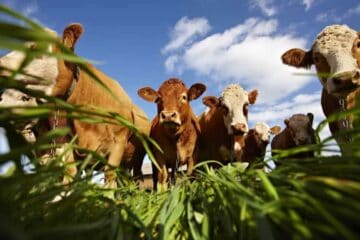Livestock Production and Management (Agricultural science/Animal Husbandry)
Livestock production involves the raising of animals for use or pleasure. Livestock production is another aspect of farming activity in addition to crop farming. There are several reasons why farmers raise various animals:
- To preserve animal life.
- To generate income from the sale of the animals.
- To meet demands for food such meat, eggs, and milk.
- To create the raw materials needed by industries like the leather and apparel industries.
- To ease the transportation and farm produce and tedious work on the farm
- To produce manure for farm crops

Requirements For Livestock Production
A successful livestock production generally depends a few things. These things consist of:
- Housing
- Feed
- Care
- Breeds
[irp]
1. Housing
Good housing is one of the fundamental prerequisites for any livestock production. Even though some animals might be permitted to roam freely, they must nevertheless be guarded by some sort of shelter.
- For ease access and capture
- To shield them from wind, rain, and sunlight.
- To keep them safe from robbers and predators.
- To give them an ideal environment where they’re going to be cared for.
- To protect animals from predators
Types Of Animal house
The kind of animal housing prepared depends upon the animals that will be raised and the products they will provide. The following list includes various kinds of animal housing:
1. Cage: A cage can be made available for raising hens. The cage may be constructed from wire mesh, bamboo, or wood.
2. Brooder: Young chickens are raised in brooders. It might be constructed from cardboard, aluminum, or wood. Typically, it provides room for feeds and water. To provide the chickens with light and warmth, electric bulbs have also been placed.
3. Hutch: Hutch is used to raise guinea pigs and rabbits. It is constructed of wire, zinc, and wood. The hutch for rabbits is typically a little different than the hutch for guinea pigs.
4. Pen/Sheds: A pen or shed is a secure area used to raise livestock, particularly sheep, goat and cattle.
Reason For A Good Animal House
Taking into account the reasons for the necessity to shelter the farm animals, the following must be met
- Provide shelter from the wind, rain, and heat.
- Offer protection from parasites and pests.
- Allow enough room for animal activity.
- Makes it simple to remove animal waste and dung; and
- Give the animals a place to keep their water and food troughs.
2. Feed
Animal food is referred to as feeds or feedstuff. Nutrients like water, proteins, carbohydrates, fats, minerals, and vitamins are found in animal feeds.
To provide the animals with a balanced ration you can combine two or more different feeds. The classes of animal feeds and their sources are listed below.
• Groundnut plants, bean seeds, soybean seeds, fish, and peas are among the animal feeds that include protein for the animals.
• Sweet potato tubers, maize seed, cassava. water leaf plants, and maize are among the feeds that give the animals carbohydrates.
• Fish meal, cotton plants, and palm fruits are among the feeds that give animals fats.
• Different kinds of grasses, cowpea plants, maize plants, water leaf plants, and soybean plants provide the minerals that animals need.
[irp]
Preparation of Of Animal Feeds
The following procedures are used to prepare livestock feeds:
1. Crushing and Grinding
The grains are ground to make it easier to combine them with other feeds. It is also feasible to prepare a balanced feedstock by grinding or crushing. The grains that have been crushed or ground make digestion easier as well. Grain grinding can be done in a mill or grinder. When a mill or grinder are unavailable, a mortar and pestle may also be utilized for small scale.
2. Slicing
Prior to feeding young animals, grasses and root feeds are typically cut into smaller bits.
Before giving them to the animals, sliced grasses and roots could be combined and allowed to sit for a while. They will become more appetizing and simple to digest as a result.
3. Cooking
On a few occasions feeds are prepared to make them appropriate for animals. When animals are fed raw feeds, they occasionally poop uncontrollably. Therefore, cooking some animal foods is a smart idea. For instance, before feeding potatoes to cattle and pigs, they must first be boiled.
3. Breeds
The choice of quality breeds of animals is another fundamental requirement for the production of livestock. Animals come in a variety of breeds. The following factors, respectively, determine how the breeds differ:
- The color of the body, first.
- The presence of horns, and
- The body’s shape
For instance, there are differences between the breeds of cattle with and without horns. Additionally, chickens have different colored, shaped, and styled combs.
Individual animals belonging to a group or species that exhibit certain traits not shared by other individuals in the group are not considered to be of the same breed.
[irp]
Characteristics Of Good Livestock
A good animal to raise is one that
- Fast growth.
- is in good health
- Is not susceptible to disease attack.



